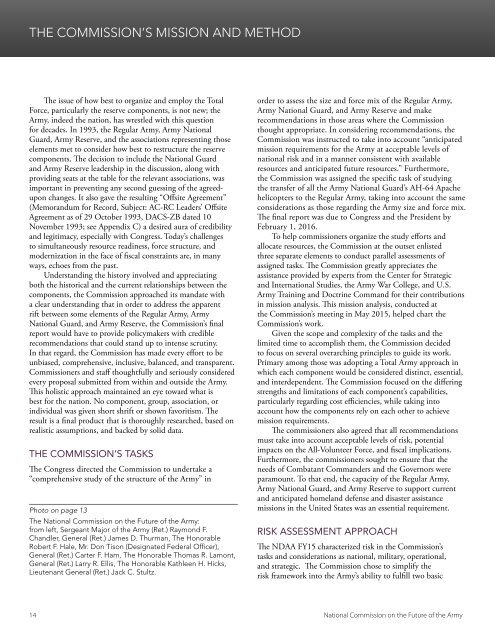THE FUTURE OF THE ARMY
NCFA_Full%20Final%20Report_0
NCFA_Full%20Final%20Report_0
You also want an ePaper? Increase the reach of your titles
YUMPU automatically turns print PDFs into web optimized ePapers that Google loves.
<strong>THE</strong> COMMISSION’S MISSION AND METHOD<br />
The issue of how best to organize and employ the Total<br />
Force, particularly the reserve components, is not new; the<br />
Army, indeed the nation, has wrestled with this question<br />
for decades. In 1993, the Regular Army, Army National<br />
Guard, Army Reserve, and the associations representing those<br />
elements met to consider how best to restructure the reserve<br />
components. The decision to include the National Guard<br />
and Army Reserve leadership in the discussion, along with<br />
providing seats at the table for the relevant associations, was<br />
important in preventing any second guessing of the agreedupon<br />
changes. It also gave the resulting “Offsite Agreement”<br />
(Memorandum for Record, Subject: AC-RC Leaders’ Offsite<br />
Agreement as of 29 October 1993, DACS-ZB dated 10<br />
November 1993; see Appendix C) a desired aura of credibility<br />
and legitimacy, especially with Congress. Today’s challenges<br />
to simultaneously resource readiness, force structure, and<br />
modernization in the face of fiscal constraints are, in many<br />
ways, echoes from the past.<br />
Understanding the history involved and appreciating<br />
both the historical and the current relationships between the<br />
components, the Commission approached its mandate with<br />
a clear understanding that in order to address the apparent<br />
rift between some elements of the Regular Army, Army<br />
National Guard, and Army Reserve, the Commission’s final<br />
report would have to provide policymakers with credible<br />
recommendations that could stand up to intense scrutiny.<br />
In that regard, the Commission has made every effort to be<br />
unbiased, comprehensive, inclusive, balanced, and transparent.<br />
Commissioners and staff thoughtfully and seriously considered<br />
every proposal submitted from within and outside the Army.<br />
This holistic approach maintained an eye toward what is<br />
best for the nation. No component, group, association, or<br />
individual was given short shrift or shown favoritism. The<br />
result is a final product that is thoroughly researched, based on<br />
realistic assumptions, and backed by solid data.<br />
<strong>THE</strong> COMMISSION’S TASKS<br />
The Congress directed the Commission to undertake a<br />
“comprehensive study of the structure of the Army” in<br />
Photo on page 13<br />
The National Commission on the Future of the Army:<br />
from left, Sergeant Major of the Army (Ret.) Raymond F.<br />
Chandler, General (Ret.) James D. Thurman, The Honorable<br />
Robert F. Hale, Mr. Don Tison (Designated Federal Officer),<br />
General (Ret.) Carter F. Ham, The Honorable Thomas R. Lamont,<br />
General (Ret.) Larry R. Ellis, The Honorable Kathleen H. Hicks,<br />
Lieutenant General (Ret.) Jack C. Stultz.<br />
order to assess the size and force mix of the Regular Army,<br />
Army National Guard, and Army Reserve and make<br />
recommendations in those areas where the Commission<br />
thought appropriate. In considering recommendations, the<br />
Commission was instructed to take into account “anticipated<br />
mission requirements for the Army at acceptable levels of<br />
national risk and in a manner consistent with available<br />
resources and anticipated future resources.” Furthermore,<br />
the Commission was assigned the specific task of studying<br />
the transfer of all the Army National Guard’s AH-64 Apache<br />
helicopters to the Regular Army, taking into account the same<br />
considerations as those regarding the Army size and force mix.<br />
The final report was due to Congress and the President by<br />
February 1, 2016.<br />
To help commissioners organize the study efforts and<br />
allocate resources, the Commission at the outset enlisted<br />
three separate elements to conduct parallel assessments of<br />
assigned tasks. The Commission greatly appreciates the<br />
assistance provided by experts from the Center for Strategic<br />
and International Studies, the Army War College, and U.S.<br />
Army Training and Doctrine Command for their contributions<br />
in mission analysis. This mission analysis, conducted at<br />
the Commission’s meeting in May 2015, helped chart the<br />
Commission’s work.<br />
Given the scope and complexity of the tasks and the<br />
limited time to accomplish them, the Commission decided<br />
to focus on several overarching principles to guide its work.<br />
Primary among those was adopting a Total Army approach in<br />
which each component would be considered distinct, essential,<br />
and interdependent. The Commission focused on the differing<br />
strengths and limitations of each component’s capabilities,<br />
particularly regarding cost efficiencies, while taking into<br />
account how the components rely on each other to achieve<br />
mission requirements.<br />
The commissioners also agreed that all recommendations<br />
must take into account acceptable levels of risk, potential<br />
impacts on the All-Volunteer Force, and fiscal implications.<br />
Furthermore, the commissioners sought to ensure that the<br />
needs of Combatant Commanders and the Governors were<br />
paramount. To that end, the capacity of the Regular Army,<br />
Army National Guard, and Army Reserve to support current<br />
and anticipated homeland defense and disaster assistance<br />
missions in the United States was an essential requirement.<br />
RISK ASSESSMENT APPROACH<br />
The NDAA FY15 characterized risk in the Commission’s<br />
tasks and considerations as national, military, operational,<br />
and strategic. The Commission chose to simplify the<br />
risk framework into the Army’s ability to fulfill two basic<br />
14 National Commission on the Future of the Army


